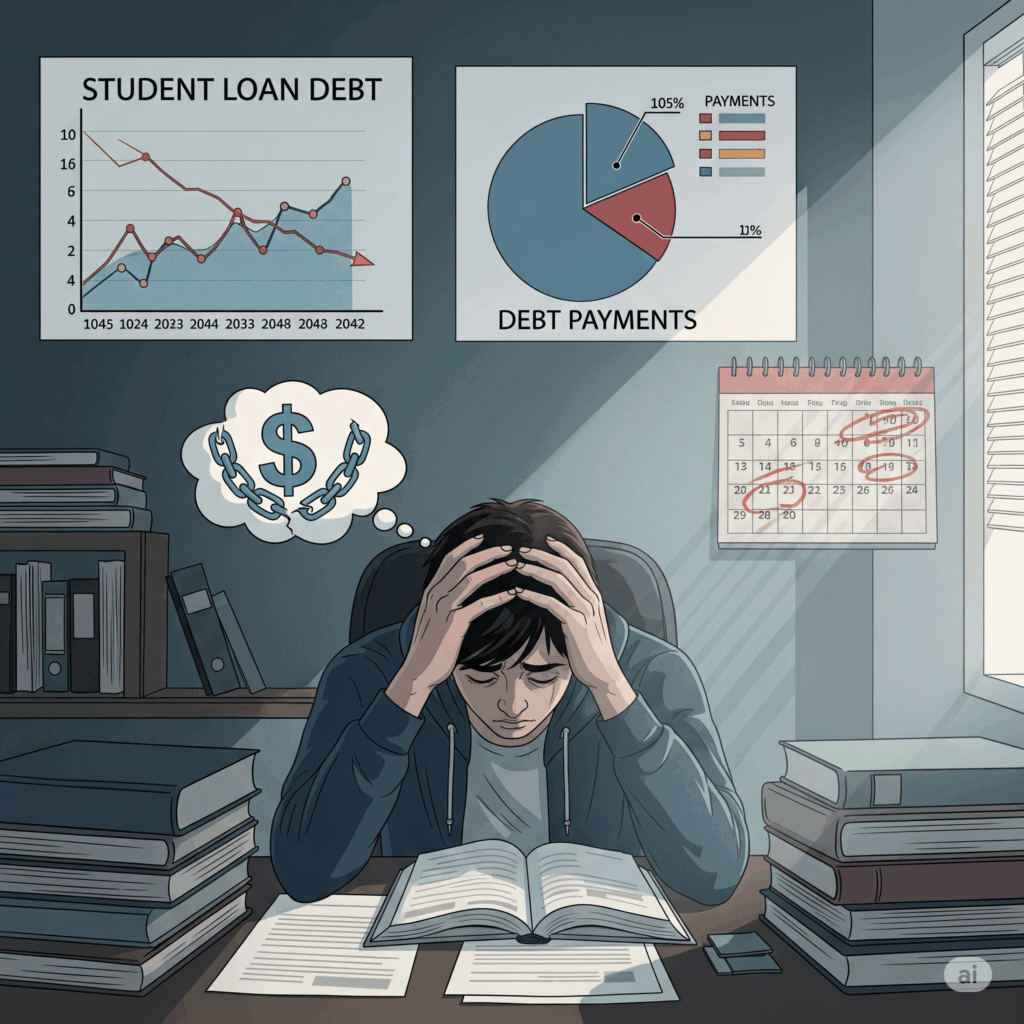The American dream, traditionally paved with access to higher education and upward mobility, is increasingly burdened by a formidable obstacle: the student loan crisis. With total student loan debt in the United States currently standing at an astonishing $1.77 trillion (as of early 2025), this financial behemoth casts a long shadow over millions of individuals and poses significant risks to the broader U.S. economy. This article delves into the multifaceted impacts of this crisis, exploring its profound effects on individual lives and its ripple effects across the national economic landscape.
The Staggering Scale of the Problem
To grasp the magnitude of the student loan crisis, it’s essential to understand the sheer volume of debt involved. Federal student loan debt alone accounts for approximately $1.693 trillion, owed by 42.7 million borrowers. The average federal student loan balance is around $38,375, though the total average balance, including private loans, can be as high as $41,618. This debt has not accumulated overnight; the average federal student loan debt has grown by a compound annual growth rate of 4.94% from 2007 to 2022. This rapid escalation is fueled by a confluence of factors, including skyrocketing tuition costs, decreased state funding for public universities, and a greater reliance on loans to cover both tuition and living expenses.
Impact on Individuals: Delayed Dreams and Financial Strain
The weight of student loan debt significantly alters the life trajectories of millions of Americans, particularly young adults.

Delayed Major Life Milestones
One of the most immediate and visible impacts is the deferral or complete abandonment of major life milestones. Research indicates that student loan debt directly correlates with:
- Delayed Homeownership: A significant percentage of student borrowers, some reports indicate over 50%, have not bought a home due to their student loan debt. Even among homeowners, a substantial portion delayed their purchase. This trend contributes to a decline in overall homeownership rates, particularly among younger demographics, and can have long-term implications for wealth accumulation.
- Postponed Car Purchases: Similarly, many borrowers put off buying a car, impacting their mobility and access to job opportunities, especially in areas with limited public transportation.
- Delayed Family Formation: The financial strain of student loans can lead to delays in marriage and having children, as individuals prioritize debt repayment over starting families. This has broader societal implications, including potential demographic shifts.
- Hindered Entrepreneurship: Aspiring entrepreneurs face a significant hurdle. Studies suggest that individuals with substantial student loan debt are less likely to start new businesses, and those who do often see lower business income. This stifles innovation and job creation, which are vital for economic dynamism.
- Limited Retirement Savings: A staggering number of adults, around two out of five, who are paying off student loans are unable to save for retirement. This not only jeopardizes their financial security in later life but also places a potential burden on future social safety nets.

Reduced Quality of Life and Mental Health
Beyond financial delays, student loan debt takes a considerable toll on individuals’ quality of life and mental well-being:
- Decreased Disposable Income: High monthly loan payments leave borrowers with less expendable income. This reduces their ability to afford daily necessities, impacting their overall standard of living.
- Increased Financial Stress: The constant pressure of debt repayment leads to significant stress, anxiety, and even depression. This can negatively affect physical health, with research linking student debt to poorer psychological functioning and even cardiovascular health problems in early-midlife adults.
- Restricted Career Choices: Some graduates may feel compelled to pursue higher-paying jobs solely to manage their debt, even if those careers don’t align with their passions or long-term goals. This can lead to job dissatisfaction and reduced productivity.
- Reliance on Social Programs: For some, the burden becomes so immense that they rely on social programs like food stamps (SNAP) to make ends meet, highlighting the systemic challenges posed by widespread debt.
Impact on the U.S. Economy: A Drag on Growth
The cumulative effect of individual struggles translates into significant headwinds for the overall U.S. economy.
Suppressed Consumer Spending
Consumer spending is a primary driver of economic growth. When millions of Americans are dedicating a substantial portion of their income to student loan payments, their capacity for discretionary spending diminishes. Economists generally agree that reduced expendable income due to debt obligations leads to a decrease in overall consumer spending, impacting various sectors from retail and hospitality to automotive and housing.
Hampered Housing Market
The direct link between student debt and delayed homeownership has a cascading effect on the housing market. Reduced demand from first-time homebuyers, who are often saddled with student loans, can depress home sales, construction, and related industries. This also impacts the broader financial ecosystem, as mortgage lending and real estate investment are less robust.
Stifled Small Business Formation and Innovation
Small businesses are critical engines of job creation and innovation in the U.S. economy. As previously mentioned, student loan debt discourages entrepreneurship, particularly for those who would rely on personal capital to start a venture. This reduction in new business formation leads to fewer jobs, less competition, and slower economic expansion. The decline in the share of start-ups founded by millennials, partly attributed to student loans, underscores this concerning trend.
Erosion of Wealth and Widening Inequality
Student loan debt disproportionately affects certain demographic groups, exacerbating existing wealth disparities. Black students, for instance, tend to borrow more frequently and in larger amounts, and face greater challenges in repayment due to discriminatory job markets. This contributes to a widening racial wealth gap, as their ability to accumulate assets and build intergenerational wealth is severely hampered. Overall, the share of total wealth held by young people has declined as they take on more student debt, making households more vulnerable to economic shocks.
Risk to Financial Stability (Though Not a 2008-Style Crisis)
While some comparisons have been drawn to the 2008 mortgage crisis, most economists agree that student loan debt does not pose the same systemic risk of a complete financial meltdown. Student loan asset-backed securities (SLABS) are a much smaller market than mortgage-backed securities, and student loan defaults, while problematic, are unlikely to trigger a widespread collapse of the financial system.
However, this does not negate the significant financial stress it imposes. High delinquency rates on student loans can negatively impact credit scores, making it harder for individuals to access other forms of credit (e.g., mortgages, car loans) and further constraining their economic participation.

The Path Forward: Addressing the Crisis
The student loan crisis is a complex issue with no single easy solution. Addressing it requires a multi-pronged approach involving policymakers, educational institutions, and individuals:
- Affordability of Higher Education: Long-term solutions must focus on making college more affordable. This includes increased public funding for universities to reduce tuition reliance, controlling administrative costs, and exploring innovative educational models.
- Improved Repayment Options: Income-driven repayment (IDR) plans like the now-phased-out SAVE program (and its replacements) are crucial, though their effectiveness and long-term viability are subject to policy changes and legal challenges. Simplifying these plans, ensuring adequate awareness, and streamlining enrollment could offer significant relief.
- Targeted Debt Relief: While broad-based loan forgiveness remains a contentious political issue, targeted debt relief for specific groups (e.g., low-income borrowers, public service workers, those who attended predatory institutions) could provide necessary relief and stimulate economic activity in specific segments.
- Financial Literacy and Counseling: Equipping students with better financial literacy before they borrow, and providing robust counseling services during and after their studies, can help them make informed decisions and navigate repayment challenges more effectively.
- Accountability for Institutions: Greater accountability for educational institutions regarding student outcomes and graduate earnings could incentivize them to provide better value for tuition costs.
Conclusion
The student loan crisis is a pressing issue that affects the fabric of American society and its economic health. It traps millions in a cycle of debt, delaying their personal and financial aspirations, and collectively acts as a drag on consumer spending, entrepreneurship, and wealth creation. While not a direct threat of a 2008-style financial collapse, its pervasive and insidious impact on individual well-being and broader economic growth demands urgent and comprehensive attention from all stakeholders. Failure to address this crisis will only perpetuate its harmful effects, undermining the very promise of education as a pathway to prosperity.










